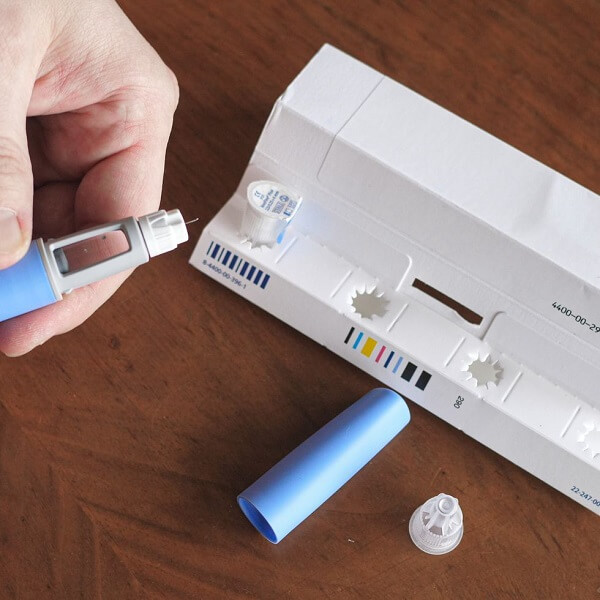Read Full Article HereWhat Is ‘Ozempic Face’? Doctors Explain Why It Happens and How to Fix It
“When TikTok and the New York Times are both abuzz about a very 2023 phenomenon known as “Ozempic face,” you know it has reached maximum social impact.
Unless you have type 2 diabetes or have been prescribed medication to treat obesity plus other chronic conditions, you may have only heard the name Ozempic from those ubiquitous commercials: “Oh, oh, oh, oh-ZEM-pic” sung to the tune of ’70s hit “It’s Magic.” But in the last few weeks, the phrase #OzempicFace has been viewed half a million times on TikTok, and the Times published a report on the topic, complete with haunting illustration of what looks like a weirdly distorted Phantom of the Opera mask.
Whispers about “Ozempic face” — a hollowed-out, loose-skinned, droopy appearance, due to losing weight quickly with the drug — first started swirling when Kim Kardashian appeared in public with “a more sculpted, less volumized face,” says Jennifer Levine, MD, a New York facial plastic surgeon who has treated many patients (not Kim) whose faces have lost fat and elasticity when they’ve lost weight quickly.
Kim hasn’t confirmed whether she took Ozempic or any other medication to help with weight loss, but since then, the drug gained major hype. However, many basic facts about the medication, who should be taking it, and, yes, how exactly it can affect your face have been lost in the shuffle.
Let’s face the facts.
First of all, what is Ozempic?
This story begins in 2017, when the FDA gave the green light to Ozempic, an injectable drug that contains the active ingredient semaglutide: “Ozempic was first approved and indicated for the management of type 2 diabetes,” explains Amy Rothberg, MD, a clinical professor of internal medicine at University of Michigan Health and spokesperson for the Endocrine Society. Ozempic is injected once a week in the stomach, thigh or upper arm, and in trials, up to 73% of people with type 2 diabetes lowered their blood sugar after using the drug.
It was quickly noted, however, that the drug also led to significant weight loss, and in 2021, the FDA approved Ozempic to treat obesity. A year later, in 2022, the FDA approved a higher dose version of Ozempic, which is now available in both 1mg and 2mg versions.
In 2021, Wegovy, which contains the same active ingredient as Ozempic but in an even higher dose (2.4 mg ), was FDA-approved specifically to treat adults with obesity or who were overweight and had at least one weight-related condition, such as high blood pressure, high cholesterol or type 2 diabetes. Elon Musk tweeted that he had used Wegovy, setting off yet another controversy over whether the tech mogul might be using the drug off-label for reasons of vanity rather than health.
There are more meds like this coming down the pike. “The newest kid on the block is Mounjaro, or tirzepatide, which has been fast-tracked by the FDA for obesity management,” Dr Rothberg adds. Mounjaro is currently approved for blood-sugar control in people with type 2 diabetes, with the FDA stating that is “more effective than the other diabetes therapies with which it was compared in clinical studies.
These drugs use a few different mechanisms to treat diabetes. First, they work by signaling the pancreas to release insulin. “When glucose is high, they lower blood sugar glucose by enhancing insulin release,” Dr. Rothberg explains. The reason why they also lead to weight loss is that they work on the centers of appetite and satiety in our central nervous system to tell us we’re fuller faster, and they slow down gastric motility, she adds.
Patients on Ozempic lose around 8 to 12 pounds, according to the company that makes the drug. In studies on people taking Wegovy, 83% lost at least 5% of their weight, and 30% lost at least 20% of their weight (or 48 pounds from a starting weight of 232). But experts stress that these are not magic weight-loss shots — they must be used in conjunction with a healthy eating plan and exercise to work.
What are the side effects of Ozempic?
Because Ozempic and drugs like it make food move through your GI tract more slowly, the main side effects include GI issues such as nausea, vomiting, constipation and/or diarrhea, Dr. Rothberg explains. In rare cases, they can cause pancreatitis or kidney injury, and animal studies have raised the concern that they can increase the risk for thyroid cancer, though that has not been shown in humans.
But the side effect that has gotten the most press is the so-called Ozempic face, in which rapid weight loss causes your face to become gaunt and hollowed-out, making you look not only thinner, but exhausted and years older.
How does “Ozempic Face” happen?
It’s a simple as this: If you lose a lot of weight in your body, you’re going to lose it in your face, too. “As babies, we start out with a lot of facial fat, and as we age, we lose some of the underlying fat that gives you a rounded cheek,” explains Jacqueline Watchmaker, MD, board-certified dermatologist with U.S. Dermatology Partners in Scottsdale, AZ. This is why children have those round, dewy, pinchable cheeks, whereas people in their 70s, 80s, and beyond tend to have more hollowed-out cheeks. In addition to the loss of fat, your skin loses its elasticity, which leads to sagging, Dr. Levine says.
“There’s that old saying in Hollywood that you can pick your face or your body,” says Dr. Watchmaker. “If your body’s a little plumper, then your face looks good, but if you lose weight throughout your body, you’ll lose it in your face, too, and the skin is going to sag a little.” Dr. Levine adds that this can happen with any type of rapid weight loss, including gastric-bypass surgery or extreme diets.
So “Ozempic face” is just really another name for “rapid weight loss face.” Dr. Watchmaker points out that there are some drugs (such as older HIV meds) that actually caused lipodystrophy, or changes to the underlying fat, but with Ozempic, the changes appear to come exclusively from the overall weight loss.
“I think the reason people notice the difference more is that it’s so rapid,” says Dr. Watchmaker, who points out that she has seen many patients who have lost 20 pounds in six weeks on the medication. “If you slowly lost weight and got a few more wrinkles every six months or so, you wouldn’t notice it as much.”
How do you fix “Ozempic face”?
Whether you have a prematurely aging face due to Ozempic or any extreme weight loss, there are a few choices for adding more shape and contour (though, keep in mind, there’s nothing to be embarrassed about and these are all pricey treatments that are not covered by insurance).
- Fillers: These are the first-line treatment, since they are minimally invasive, don’t require a lot of downtime, and are less expensive than other options, says Dr. Watchmaker. “With most of the patients I see who are in their 40s or 50s and have lost weight, we use fillers to rebuild the structure around the cheek area, where you see the most fat loss,” she says.
- Skin-tightening treatments: Even if you add back volume through fillers, the skin is not just going to snap back, says Dr. Levine. “Restoring the skin’s elasticity from loss of collagen and elastin is harder to counteract, because it’s like a rubber band that’s been overstretched—you can’t get it to just bounce back to how it was before.” Therefore, she says, treatment for “Ozempic face” may also involve skin lifting or tightening to help reduce sagging.
- Plastic surgery: In some cases, the only way to truly turn back the effects of would be a surgical face lift, says Dr. Levine. Her advice? “When it comes to weight loss, slow and steady is always best.”
Bottom line on taking Ozempic and medications like it:
Though these medications should only be prescribed by a physician with expertise in endocrinology or obesity — and only to people with type 2 diabetes or obesity and related health concerns — many outlets have reported that people are obtaining the drugs as a quick way to lose weight, either off-label or even by asking a compounding pharmacy to create a version for them. This has helped contribute to a shortage of both Ozempic and Wegovy, according to the FDA.
“These are not vanity drugs,” says Dr. Rothberg. “People who take them need to be medically monitored, not just for the side effects but for their other conditions, which might include not only type 2 diabetes, but hypertension and cardiovascular disease.” It’s also important that you understand all short- and long-term side effects of using any medications.
And it’s worth noting that if you take any of these drugs without a diagnosis of obesity and/or type 2 diabetes, insurance won’t cover the cost, which can reach $1,000 a month or more.”
What Is ‘Ozempic Face’? Doctors Explain Why It Happens and How to Fix It
February 8, 2023









